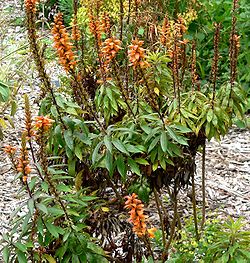
Isoplexis
Encyclopedia

Species
In biology, a species is one of the basic units of biological classification and a taxonomic rank. A species is often defined as a group of organisms capable of interbreeding and producing fertile offspring. While in many cases this definition is adequate, more precise or differing measures are...
within the genus
Genus
In biology, a genus is a low-level taxonomic rank used in the biological classification of living and fossil organisms, which is an example of definition by genus and differentia...
Digitalis
Digitalis
Digitalis is a genus of about 20 species of herbaceous perennials, shrubs, and biennials that are commonly called foxgloves. This genus was traditionally placed in the figwort family Scrophulariaceae, but recent reviews of phylogenetic research have placed it in the much enlarged family...
. The species of section Isoplexis differ from other plants in the genus Digitalis
Digitalis
Digitalis is a genus of about 20 species of herbaceous perennials, shrubs, and biennials that are commonly called foxgloves. This genus was traditionally placed in the figwort family Scrophulariaceae, but recent reviews of phylogenetic research have placed it in the much enlarged family...
in that their monosymmetric (sometimes called zygomorphic) flowers have a distinctive large upper lip rather than large lower lip and the species are endemic to the Canary Islands
Canary Islands
The Canary Islands , also known as the Canaries , is a Spanish archipelago located just off the northwest coast of mainland Africa, 100 km west of the border between Morocco and the Western Sahara. The Canaries are a Spanish autonomous community and an outermost region of the European Union...
(the species D. canariensis, D. chalcantha, and D. isabelliana) and Madeira
Madeira
Madeira is a Portuguese archipelago that lies between and , just under 400 km north of Tenerife, Canary Islands, in the north Atlantic Ocean and an outermost region of the European Union...
(D. sceptrum).
Two Isoplexis species were first described by Linnaeus in 1753 as part of the genus Digitalis, these were D. canariensis and D. sceptrum. Since then the section has undergone several changes, the addition of two more species and more importantly being moved to a separate genus, under the genus name of Isoplexis or sometimes Callianassa, back and forth many times (Lindley 1821, Loudon 1829, Bentham 1835, Webb 1845, Wetstein 1891, Himmelbaeur and Zwillinger 1927, Werner 1960-1966, Heywood 1972). The position of Isoplexis as a section within Digitalis was finally proven by Carvalho in 1999 using molecular data and published by Brauchler et al. in 2004.
Isoplexis species grow in woody habitats: D.canariensis in humid woodland areas and rarely in dry woodland areas, D.isabelliana in Pinus canariensis woodland and open disturbed areas, D.sceptrum in the cloud zone community Clethro-Laurion (Sjogren 1972) near streams on steep slopes, and D.chalcantha in Canary Island laurel forest
Laurel forest
Laurel forest is a subtropical or mild temperate forest, found in areas with high humidity and relatively stable and mild temperatures. They are characterized by tree species with evergreen, glossy, enlongated leaves, known as laurophyll or lauroide...
.
The flowers of Isoplexis species appear to be adapted for bird pollination. It was once thought that the original pollinators of Isoplexis and the other Canarian bird pollinated plants (such as members of the genera Canarina
Canarina
Canarina is a genus of flowering plants within the family Campanulaceae. The best known species is C. canariensis from the laurel forests of the Canary Islands which is sometimes grown as an ornamental plant...
and Lotus
Lotus (genus)
Lotus is a genus that includes bird's-foot trefoils and deervetches and contains many dozens of species distributed world-wide. Depending on the taxonomic authority, roughly between 70 and 150 are accepted. Lotus is a genus of legume and its members are adapted to a wide range of habitats, from...
) were sunbird
Sunbird
The sunbirds and spiderhunters are a family, Nectariniidae, of very small passerine birds. There are 132 species in 15 genera. The family is distributed throughout Africa, southern Asia and just reaches northern Australia. Most sunbirds feed largely on nectar, but also take insects and spiders,...
s which had become extinct on the Canary Islands; this might explain why Isoplexis species are rare and considered endangered species
Endangered species
An endangered species is a population of organisms which is at risk of becoming extinct because it is either few in numbers, or threatened by changing environmental or predation parameters...
(Vogel 1954; Vogel et al. 1984; Valido et al. 2004). However more recent work has shown that these plants are adequately pollinated by non-specialist flower visiting birds, particularly the Canary Island chiffchaff
Chiffchaff
The Common Chiffchaff, or simply the Chiffchaff, is a common and widespread leaf-warbler which breeds in open woodlands throughout northern and temperate Europe and Asia....
(Phylloscopus canariensis), and the Canary Sardinian warbler (Sylvia melanocephala leucogastre) (Olesen 1985, Ollerton et al. 2008), and in fact show some specific adaptations to infrequent pollination by these birds, such as extended flower lifespans (Ollerton et al. 2008), and a hexose-dominated sugar ratio in the composition of the nectar (Dupont et al. 2004).
Some of this text has been modified from Toomey, N (2004) Investigation of the phylogenetic utility of Cycloidea-like genes in various angiosperm lineages. PhD Thesis, The University of Reading, England.

